
New Best Tool to Translate YouTube Video to Arabic

Best Tool to Translate YouTube Video to Arabic
Arabic is the sixth most spoken (and understood) language in the world. According to Wikipedia, there are approximately 422 million Arabic speakers (native & non-native). If you are a content creator, translating English videos to Arabic presents an opportunity to reach such a wide audience. In this article, we will present one such tool that can help you translate video to Arabic with ease. We will also discuss common challenges in translating videos to Arabic and how our recommendation overcomes them. So, without further ado, let’s dive in.
Part 1. Common Challenges In Translating English Videos Into Arabic
Below are some common challenges you face when you want to translate videos to Arabic.
Lack of Semantic Nuances
Arabic is a very rich language with semantic nuances. As it exhibits a distinct linguistic structure, taking care of linguistic and cultural nuances is the main challenge in accurately capturing the meaning during translation.
Translating Idiomatic Expressions
Translating Arabic idioms, colloquialisms, and culturally specific expressions is difficult as these may not have direct or indirect equivalents in (say, for example) English. AI tools, in particular fail to accurately translate such sentences.
Considering Sentence Structure Variations
Maintaining coherence and natural flow is essential for effective communication. Arabic follows a very different sentence structure, complicating the translation process. For example, it is written from right to left, therefore, the translation will be read in the opposite direction.
Translating Gender and Formality
Arabic includes gender-specific pronouns and formal/informal distinctions, whereas English is more neutral towards gender. Ensuring appropriate gender and formality in translations is crucial for cultural sensitivity.
Lack of Technical Vocabulary
Technical terms may lack direct equivalents in Arabic. For example, the term “Artificial Intelligence” has no equivalent translation in Arabic. Not all AI tools will translate these terms to accurately convey the meaning. Therefore, we recommend only the best.
Part 2. Best Tool for Translating Videos Into Arabic
Translate Video Online Translate Video on Win
Wondershare Virbo is a groundbreaking tool that takes care of all these challenges while translating videos from Arabic to English and English to Arabic. It uses highly advanced AI machine learning algorithms and language models to analyze the context of a spoken word. It then translates and generates text in the target language. Virbo supports 20+ languages, breaking language barriers and helping you reach a wider audience. The premium plan gives you access to its entire feature set. But if you’re using the free plan, Virbo allows translations of 2-minute videos and 500 Mb files. Unfortunately, Virbo doesn’t work with YouTube links. So, if you want to translate YouTube video to Arabic, you have to download it first.
Unique Features of Virbo AI Video Translator
- Can translate video to Arabic free
- Supports 20+ Language
- Highly accurate and concise translations
- Auto-generate scripts if necessary
- AI Voice Cloning feature for Live Videos
- The lip sync precision feature is supported
Limitation
- Cannot translate YouTube videos to Arabic directly from the link (you have to download it first)
Compatibility
Wondershare Virbo is available on the following platforms:
- Windows - You can install Virbo software on your Windows computer/laptop
- Android - You can get Virbo android app from the official Google Appstore
- iOS - You can download Virbo on Apple iOS devices like iPhones and iPads
- Online - You can translate YouTube video to Arabic online
Language Support
Currently, Virbo supports the following languages:
Original Language: English, Chinese, Spanish, Arabic, Portuguese, Indonesian, French, Russian, German, Japanese, Italian, Korean, Thai, Filipino, Bengali, Turkish, Dutch, Swedish, Croatian, Romanian, Czech, Hindi, Ukrainian, Vietnamese, Malay, Slovak, Danish, Tamil, Polish, Greek, Finnish, Burmese, Urdu.
Translated Language: English, Spanish, German, Portuguese, Italian, Indonesian, Chinese, Japanese, Arabic, Filipino, Korean, Hindi, Russian, French, Dutch, Turkish, Polish, Swedish, Bulgarian, Romanian, Czech, Greek, Finnish, Malay, Slovak, Danish, Tamil, Ukrainian.
Translate Video Online Translate Video on Win
Part 3. Easy-Follow Steps to Translate Videos Into Arabic
To start translating your videos from English to Arabic, download Virbo from the official Wondershare website or just click the “Translate Video on Win” button below to download Virbo and install this video translator on your computer. You can also use the online tool or its Android or iOS app to do so. Now follow the steps below to translate video from English to Arabic.
Step 1Upload Your Video
Translate Video Online Translate Video on Win
Launch Virbo and go to Video Translator Tool in the top right corner. Now, upload your video.
Note: You can choose any video between 30 seconds to 2 minutes and a 500 MB file size.
Step 2Select Source and Target Language

Once your video finishes uploading, you will see the option to select Source and Target languages. Select English as the source and Arabic as the Target language.
Step 3Generate your translated Video

Click on Generate Video to begin the video translation process. It will take some time so be patient.
When the translation finishes, preview it. If everything is fine, click on Download Video to save your video offline. Easy peasy!
Translate Video Online Translate Video on Win
Part 4. Frequently Asked Questions (FAQs)
01of 04Is Virbo Free?
Yes, Virbo software is free to download and use. It has a free plan that lets you translate 2-minute videos (500 MB max) without costing a dime. The premium plan gives you access to more features and allows longer videos.
02of 04What languages does Virbo support?
Virbo currently supports 20 languages and constantly working to add support for more languages. With Virbo, you can translate to and from these languages with ease. For a complete list, check out the Part 2 section above.
03of 04Does Virbo generate subtitles?
Yes, the Virbo online tool automatically generates subtitles. You can edit and customize them if necessary. It also gives you the option to download subtitles as SRT files once you are done. Note: This feature is only available for the Virbo online tool.
04of 04How accurate is English to Arabic or Arabic to English translation generated by Virbo?
The translation accuracy of Virbo is approximately 98.6%, thanks to the utilization of the latest AI technology. It utilizes advanced machine learning mechanisms to ensure contextually relevant translation. However, there’s still a minor chance of error. So, get some human eyes to review the generated text before finalizing.
Conclusion
Arabic to English and vice versa translation can be a bit tricky for common AI translation tools. However, with the right tool, such as Wondershare Virbo, you can translate YouTube video to Arabic online or offline. This way, content creators can seamlessly bridge any and every language barrier. Embracing these latest solutions enhances accessibility, fosters cross-cultural understanding, and makes video content more inclusive and impactful on a global scale.
Translate Video Online Translate Video on Win
The Ever-Changing Era of AI Video Translation: A Reality to Be Fulfilled
The landscape of video creation is continuously evolving with the advancement of AI. It has reduced the manual efforts of video production with automated processes. Content creators translate their videos for a powerful impact on the audience. In this regard, they prefer AI translate video tools to translate large volumes of videos.
Otherwise, human translators and related equipment prove costly. That’s why it’s a practical solution when overseen by humans for quality assurance. So, this article will show the practical applications of translating video content. Besides, you will find the best online tools that offer AI translate video features.
Part 1. Wondershare Virbo: Breaking the Barriers in AI Video Translation
Wondershare Virbo is an AI tool that can translate videos into over 300 languages and voices. It can generate engaging AI-talking avatar videos with natural-sounding voices. Such videos can boost your digital marketing campaign with attractive content. AI videos remove the need for employee training resources and live trainers. Overall. It reduced the traditional learning costs while creating the most impactful videos.

Get Started Online Free Download
Video Translator Feature – A New Addition
This feature of Virbo offers AI to translate video into selected voices along with subtitles. Users can upload their video, ranging from 10 seconds to 2 minutes. Moreover, it allows you to check the option of an AI generator for translated subtitles. Later, you can hit the keep background music option that will only change human voices.
After uploading a video, you must pick the original language of the video. Then, you should choose a language for voiceover or translation. Also, users can select the accent or tone of the translated voices from the given options.

Other Notable Features of Wondershare Virbo
1. AI Avatar
They are digital representations of humans to present without revealing identity. This AI tool offers natural-looking avatars of more than 300. You can select any avatar by specifying a search with Gender and attire filters. After choosing an Avatar, users can set their background from business or other groups.
2. AI Voice
This feature of Virbo allows you to convert text into speech. It is regularly updated to match your needs. You can get many voice tones like calm, energetic, mature, gentle, and fluent. It allows you to adjust the volume, speed, and pitch of the AI-generated voice. Furthermore, users can change the gender and language of the voice as required.
3. AI Script Generator
Save your time and get a customized script with the integration of ChatGPT and Virbo. It creates engaging, lengthy, or professional type of content from smart optimization. Users can also paste their script and prompt to re-write that text. When you get the desired script, choose portrait or vertical mode to create the video.
4. Talking Photos
Make your photos speakable by using this feature of Virbo. For this purpose, you have to upload a straight-looking face picture instead of a selfie. Apart from importing any image, you can select any AI photo from the given options. Later, users have to paste their script to make a talking photo.
5. Video Templates
Pick a well-crafted video template instead of editing from scratch. There are video templates from festivals, e-commerce, advertisements, and many other domains. Despite selecting from such domains, you can search for a template with a topic input. You can still customize the chosen template by changing the background or adding text to it.
Get Started Online Free Download
Part 2. What Are the Basic Applications of Translating Video Content?
Translating video is not only about language; it’s also about making content reachable. It ensures that the message is delivered impactful across cultures and regions. Translating content can connect people from different linguistic backgrounds. It removes language barriers whether you belong to the education or business sectors. Thus, get to know more applications in the given section:
1. Healthcare and Medical
Medical professionals consider AI translate video for many healthcare aspects. Mainly, they use translated content for communicating with different language-speaking patients. It is also used to share research findings and medical training globally. This way, international participants are able to easily understand the informative discussions.
2. Legal and Compliance
It refers to translating video content that complies with legal requirements. In such cases, legal documents, contracts, and related videos are translated. This way, users ensure that everyone can understand the multinational business that they are signing. It is important because any misinterpretations can cause legal disputes.
3. Entertainment and Media
This industry is currently using AI translate subtitles more than other domains. The media industry translates movies, TV shows, series, and other streaming content. It allows a broader universal audience through subtitles and dubbing. You might have also observed streaming services like Netflix and Disney+ relying on video translations. They invest in dubbing videos to reach international subscribers.
4. Tourism and Hospitality
Travel agencies look for promotional videos that can showcase culture and destinations. These videos are translated into Spanish, Chinese, or English languages to attract tourists. Translated videos can provide virtual tours of historical places or guide visitors. Restaurants also use translated videos to explain dishes and menus to international tourists.
5. E-learning and Education
Educationists and trainers can create bilingual courses through video translation. They use AI translate videos to customize learning paths for diverse learners. It is especially fruitful for non-English speakers to learn in their native language. Besides, enabling translated subtitles can help slow-paced or impaired learners in grabbing concepts.
Part 3. How Is AI Influencing Video Translation on a Practical Level?
Technology advancements put video creation and editing at ease. The emergence of Artificial Intelligence has positively influenced video translation and creation. It makes the process accurate, cost-effective, and accessible to all. Content creators, businesses, and educationists are filling the language gaps with translated videos. So, let’s learn how AI influences video translation without further delay:
1. Voiceovers and Dubbing
AI-powered tools can generate natural-sounding voiceovers in different languages. Such dubbing and voiceovers are not much more distinguished than human voices. You can get multiple translated videos with the use of machine translation models. Moreover, they can add automatic subtitling on streaming services like YouTube and Vimeo.
2. Language Learning
Students can listen to native speakers and receive translations with AI algorithms. It enables them to grasp the pronunciation of words and learn their meanings. When students watch videos with translated subtitles, they can identify their weak areas in learning. It can also help in improving the vocabulary and grammatical skills of learners.
3. Multilingual SEO
Multilingual SEO means optimized content on search engines and websites. Its primary goal is to improve visibility across different regions and languages. Translation and localization of video content can expand discoverability in various locations. AI algorithms analyze user experiences and suggest relatable or user-preferred language content.
4. Real-time Translation
AI translate video provides solutions to live broadcasting and video seminars. It proves valuable for international news, reporting, events, and global business meetings. AI-driven translation systems recognize speech and provide translation on the screen. The natural language processing and machine learning models detect conversation for translations.
5. Enhanced Post-Editing
Human translators can get help from AI in an exact and faster translation process. In this regard, machine translation systems can provide a baseline that humans can refine. They can adjust translations to fit with the context and tone of the video. You can get assistance to remove potential errors in translation, like terminology discrepancies.
Part 4. Some Pre-Existing Online Tools Offering AI Translation
Online translating tools are beneficial for efficient and affordable solutions. They make global communication accessible and correctly align with growing users’ needs.
The internet is full of online software for AI translate subtitle generation. Selecting a secure and reliable tool is still a concern to get high-quality outputs. Thus, we have enlisted some of the best online AI video translating tools to ease your selection.
1. VEED.io
VEED.io is an online tool for recording and editing professional videos on one platform. This video editing tool can translate your subtitles into different languages manually. It enables you to upload a subtitles file and adjust the video as required. Besides, it claims to produce 98.5% accurate translation and subtitling services.

Key Features:
- Upload subtitle files with VTT, TXT, and SRT formats to get subtitles added to the video.
- Offers preset styles library and effect library for subtitles.
- Allow manual changes of subtitle check-in and check-out timing in the video.
2. Maestra
This AI-powered tool offers voice-overs, transcriptions, and caption-generating services. Users have to upload their audio or video files to translate into more than 100 languages. Besides using this AI translate video for subtitles, you can get dubbing of videos with your chosen speakers. After generating subtitles, you can edit and export into PDF, TXT, SRT, and VTT formats.

Key Features:
- Change subtitles’ font style, font size, color, positions, and characters per line.
- Collaborate and give access to teammates for editing auto-generated subtitles.
- Embeddable player allows you to export the generated subtitles without downloading the video.
3. Kapwing
Edit, trim, and enhance videos with this AI tool with cutting-edge technology. AI translate subtitle is one of its features in terms of AI video creation and editing. You can paste a YouTube video link or upload a file from Google Drive and Google Photos. After getting subtitles, users can translate them into different languages or edit them.

Key Features:
- Adjust characters per subtitle in your video as desired.
- Resize the video canvas for direct sharing on social media platforms.
- You can browse misspelled words and manually correct them.
4. HeyGen
HeyGen is originally an AI video creator but also offers a video translation feature. To translate a video, you have to upload an MP4 video with a 500 MB file size. The file size uploading limit depends on the credits and plan you are using. It requires uploading videos of 30 seconds minimum and 5 minutes maximum.

Key Features:
- Despite uploading an MP4 video, you can make a video from a webcam in HeyGen.
- Gives you the option to translate video or translate audio files.
- Multi-speaker translation and proof translation options are available in its enterprise version.
5. Wavel.AI
Elevate videos, films, and presentations with this video dubbing and subtitle-generating AI tool. It offers translation in over 40 languages with male and female voices. You can upload a 2-minute video of 100 MB while using its free version. The generated subtitles can be split, merged, and added to the video according to users’ preferences.

Key Features:
- Users can highlight and strikethrough the subtitles text in the video.
- You can set minimum and maximum subtitle duration in the clips.
- It allows you to choose the emotion, pitch, volume, and speed of the translator.
Conclusion
To sum up, AI has reduced the manual efforts in the video production and editing industry. Now, you don’t have to translate video through professional translators. For this purpose, AI tools can serve different fields of video translation. This article has also discussed the practical applications of AI translate video tools.
In search of the best translation tool, you can rely on Wondershare Virbo. This AI tool has all the essential features to create an AI avatar video and translation. That’s why digital creators and other professionals prefer this AI tool.
Get Started Online Free Download
SRT Subtitle Translation: Tools and Techniques
In a multilingual world, the single largest barrier to effective communication is language. Nobody knows all the languages spoken around the world, do they? What to do to break this barrier of communication? In the domain of audiovisual content such as on YouTube, we leverage subtitles to break that barrier. How? By using online SRT translation software to auto translate SRT file into the language of our audience. Sounds fascinating? Read on to learn how to translate SRT online yourself!
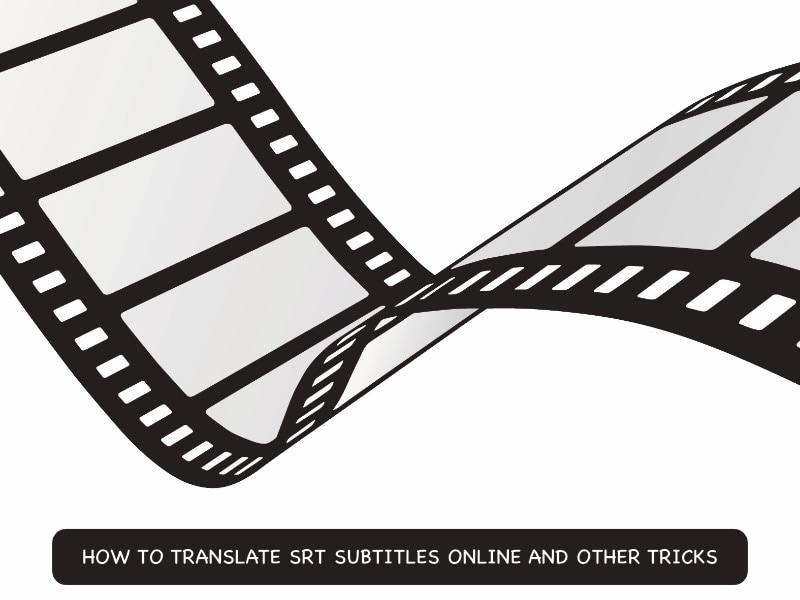
Part 1: Why Is Using Online SRT Translation Tools Recommended?
You might be wondering why you would translate SRT subtitles online when you can do them yourself. The simple answer is that you cannot translate SRT subtitles online and reach a global audience by yourself. You might know one language, or two, or maybe five or ten. Twenty? Okay, you might know 20 languages. According to UNESCO World Atlas of Languages (UNESCO WAL) there are over 7000 languages in use. You certainly do not need to know or translate into those many.
To reach a global audience of 195 countries (193 recognized by UN) you only need a handful, and you might be able to get by with what you know. But, how about using an online SRT file translator to get the job done faster, more accurately, and in a greater number of languages than you can? This way, you free up your time to do more important tasks than being a translator!
- Online SRT translation is fast.
- Online SRT translation is efficient and timesaving.
- Online SRT translation is accurate (depending on chosen tool).
- Online SRT translation translates into many more languages than we know.
- Online SRT translation allows us to reach a larger audience.
- Content engagement shoots up due to wider availability of subtitles.
- User retention rate increases as a larger number of users can connect with your content due to subtitles in their native language.
Part 2: Top Online SRT Translation Tools
What are the top SRT translation tools online available to us today? Let’s dive into them and give you a gist and their pros and cons!
2.1: Translate Subtitles
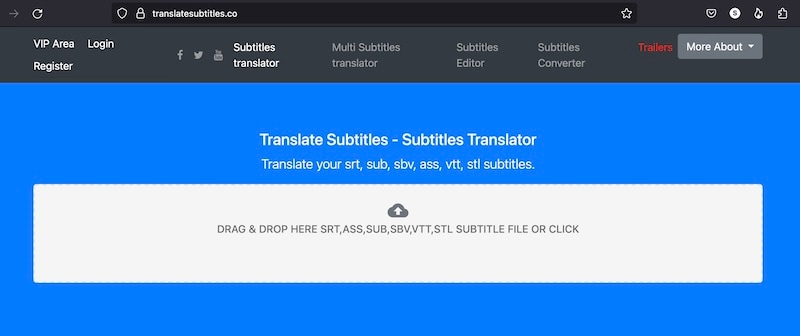
One of the best online SRT translate tools, Translate Subtitles is an online SRT translator that is easy and intuitive to use. We are classifying the features into Pros and Cons.
Pros
- Supports 6 subtitle formats (srt, sub, sbv, ass, vtt, and stl) for translation.
- Can translate into all languages that Google Translate supports.
- Can translate 20 files at once.
- Free to use.
Cons
- Uses Google Translate, so it is as good or bad as Google Translate.
- Supports file size up to 1 MB only.
2.2: Subtitles Translator
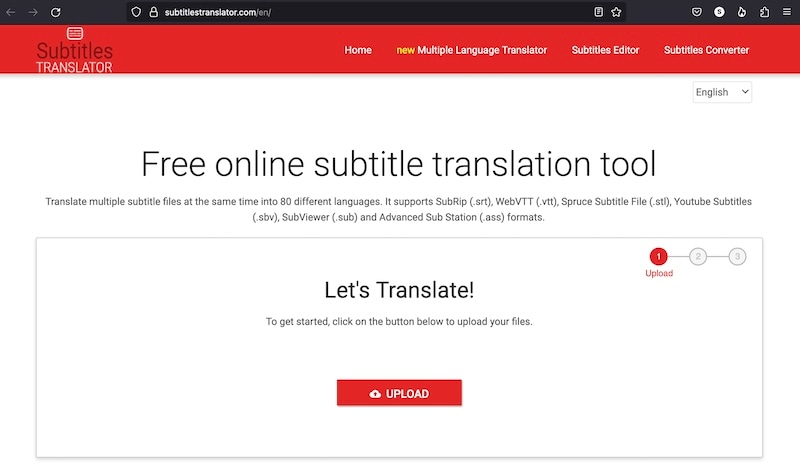
Subtitles Translator is another powerful online subtitle translator you can use, with features similar to Translate Subtitles.
Pros
- Can translate 20 files at once.
- Supports the same 6 file formats as Translate Subtitles (srt, sub, sbv, ass, vtt, and stl).
- Provides a subtitle converter to convert between subtitle formats.
- Provides a subtitle editor you could use to make changes.
Cons
- Maximum file size supported is 1 MB only.
2.3: Maestra AI
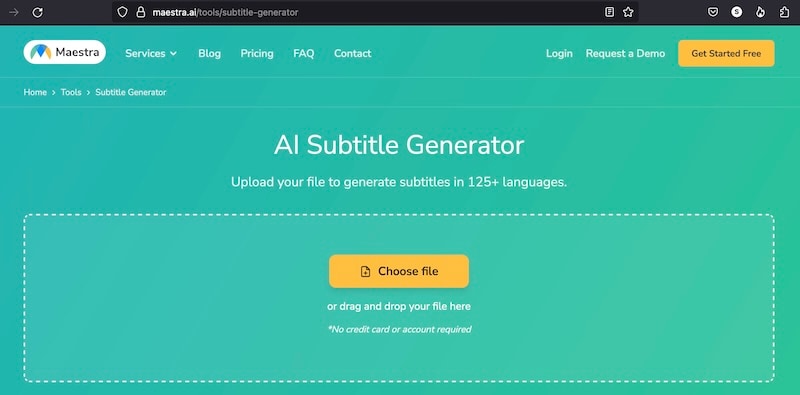
Maestra is one of the most powerful subtitle translators online. Its feature list will have you drooling over it, but it does not come without its cons. Here are the pros and cons of Maestra.
Pros
- Support for over 125 languages.
- Easy to use and fast subtitle translator.
- Subtitle editor available to make changes.
Cons
- Pricing could be a turn-off for some users.
2.4: VEED.IO
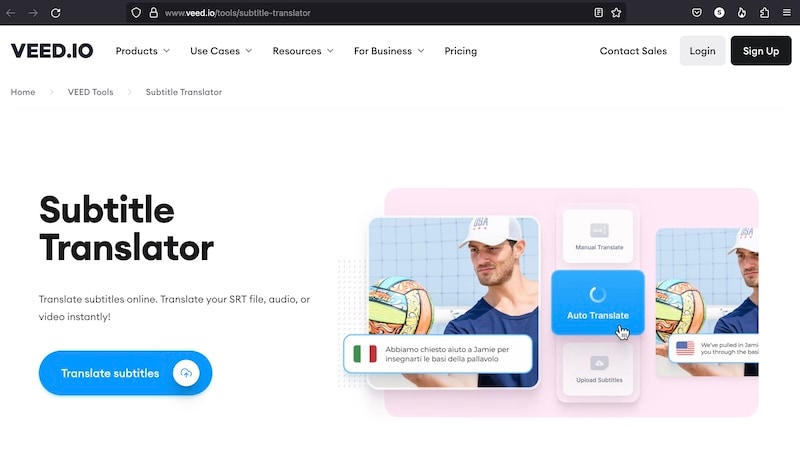
VEED.IO is a popular subtitle translation online software that offers better accuracy than some of the other competitors as its unique selling point.
Pros
- Better accuracy than some other online SRT translation tools.
- Subtitle can be downloaded in a different subtitle format.
- Direct upload of files from YouTube is possible.
Cons
- Can be expensive to use owing to features you might not need.
2.5: Media.io
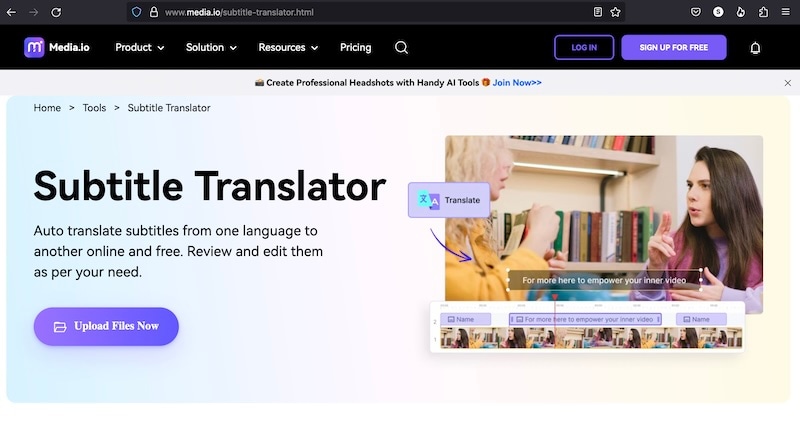
Media.io is a product from Wondershare Company, which means that it has all the hallmarks every other Wondershare product comes with – legendary ease of use married with unparalleled power. What can Media.io do for you?
Pros
- Media.io supports 127 languages.
- Translated subtitles match the audio/ video automatically.
- Rich subtitle editor offers the best way to edit, customize and stylize subtitles.
- Included video editor offers a full spectrum of useful features such as the ability to add music, elements, logos, voiceovers, etc.
- Powered by AI (artificial intelligence) for leading accuracy.
Cons
- Free version limited to a file size of 250 MB.
2.6: smartcat
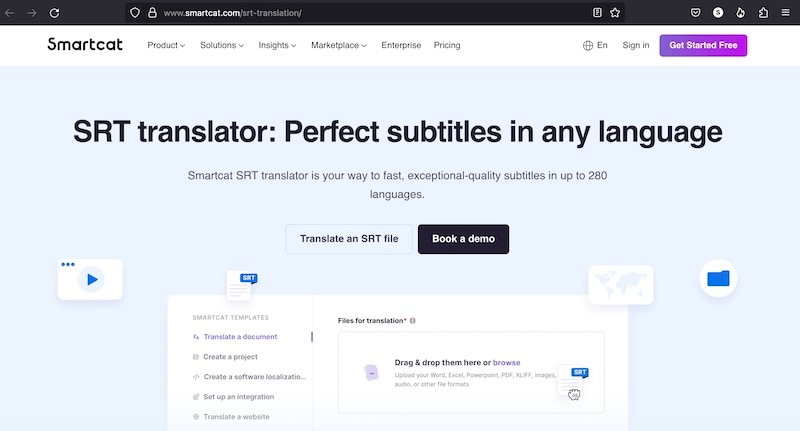
Smartcat deserves a special mention in the online srt translation space due to its support for 280 languages. Yes, you read that right. It supports those many languages! Here are some pros and cons of Smartcat.
Pros
- Support for over 280 languages!
- Over 90% accuracy rate.
- Ability to collaborate with people to edit subtitles.
- Sharing is possible.
Cons
- There is an intriguing word count limit of 150,000 words per year for translation.
Part 3: How To Choose The Best Tool To Translate SRT File
Now, with all those options looking rather equally viable, how do you choose? Do you just pick one and go? Well, yes and no. If you just want to see how things work, any of those options is going to serve as a good measure. However, when you want to translate SRT subtitles online in a more professional way wherein your reputation and image are on the line, you want the best of the best. Here is how to choose just the right online subtitle translation tool for you.
3.1: Ease of Use
How easy is an online subtitle translation software to use? Most online SRT translation tools boast a simple, 3-step process. You will not find much variance here, because it is just a simple upload, translate, and download process.
3.2: Editing Features
Online SRT subtitles translator software may provide you with editing features. These editing features can be used to differentiate between products and are worth looking into. If one online editor does not have something that the other offers, clearly the other is your tool, other factors notwithstanding.
3.3: Format Support
Most software to translate SRT online support a number of subtitle formats. However, one or two might not support the format you want to use, so check the number of formats supported before using an online tool to translate SRT subtitles.
3.4: Translation Accuracy
When translating subtitles online, you want an online SRT translation tool with the highest possible accuracy to have a reasonable surety with respect to the quality of the translated subtitles. You do not want to appear immature and unprofessional due to poor quality of subtitles, do you?
3.5: Data Privacy
Now this one is KEY. No matter how good that online SRT translator AI tool is, you do not want to use it for your subtitles if that tool does not afford you a rock-solid data privacy. When you upload SRT to an online SRT translation software, what does that software do with your file afterwards? Does it store it forever? How is the communication between your device and their server happening? These are important questions that need clear answers for any user, but especially so when translating sensitive content or proprietary content.
Part 4: How To Use An Online SRT Translation Tool To Translate SRT Online
Let’s get down to using an online SRT translation tool to translate an SRT file online. We will use Media.io for the purpose.
Step 1: Launch the online subtitle translator tool and click Subtitles from the sidebar.
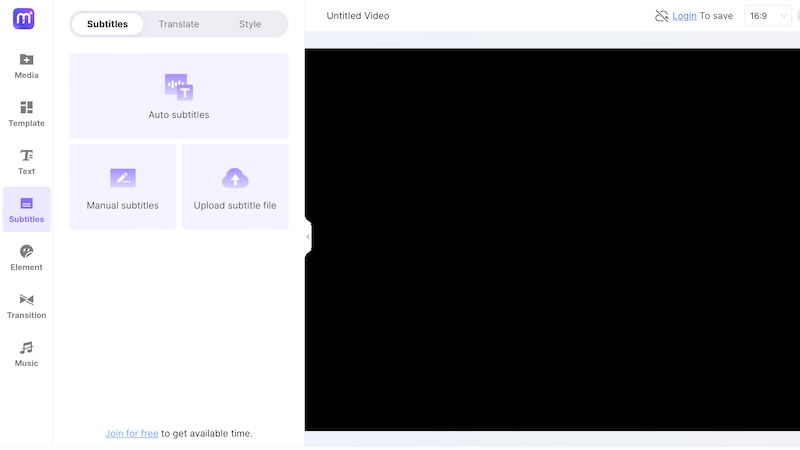
Step 2: Click Upload Subtitle File and upload your subtitles. Subtitles will be loaded and shown.
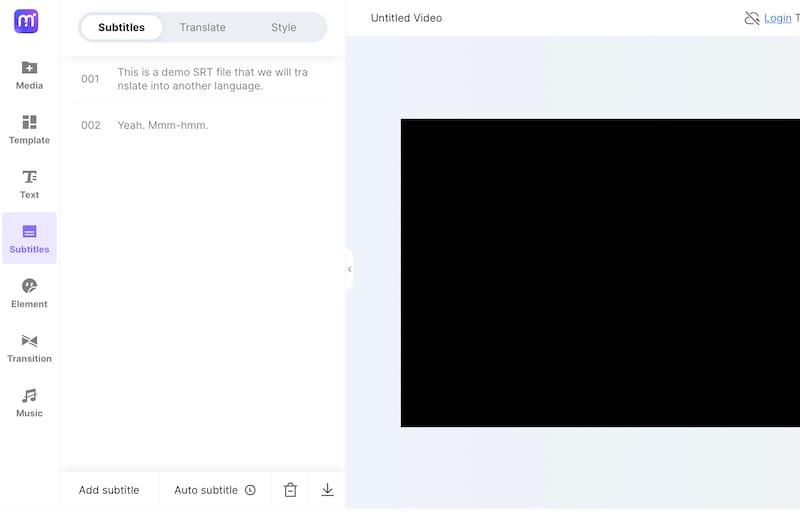
Step 3: In the tab above, click Translate and select a target language from the dropdown and click Translate.
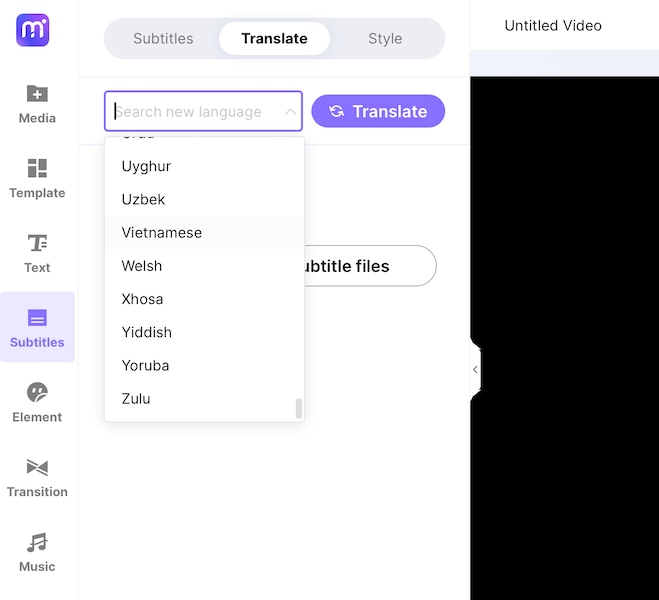
Step 4: When the subtitles are translated, download the subtitles in the format you want. That’s it!
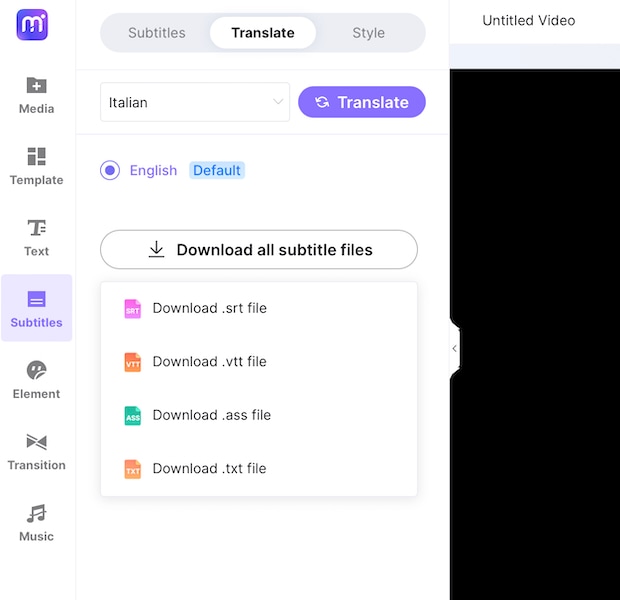
Bonus Tip: Translate Video To Any Language Of Your Choice With Virbo
Apart from subtitles, what about videos? Can we translate videos online easily? Yes! There is just the tool for that, too!
Wondershare Virbo: The Ultimate Online Video Translator
Wondershare Virbo was designed and developed with you in mind. It is by far the easiest way to translate videos online. Here are the steps to use Wondershare Virbo to translate your videos online.
Translate Video Online Free Download
Step 1: Go to the Wondershare Virbo Online website.
Sign In with Google, Facebook, Twitter or Apple ID, or use your existing Wondershare Account. Else, create a new Wondershare Account and proceed.
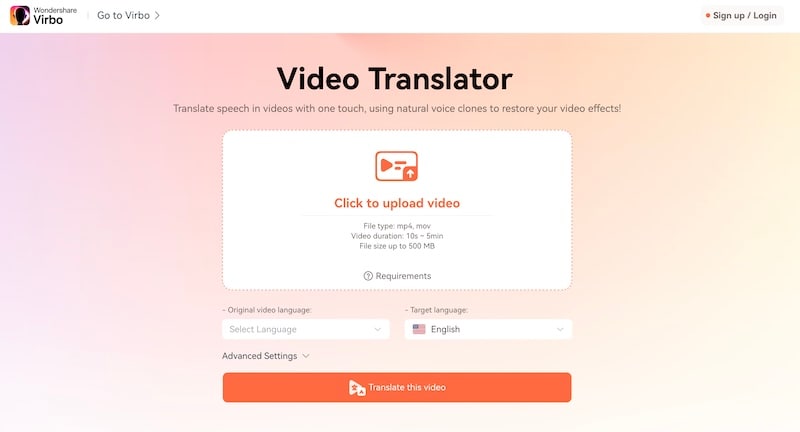
Step 2: Add a video to translate. Then, choose the original video language and the target translation language, that is, the new language you want to translate your video to.
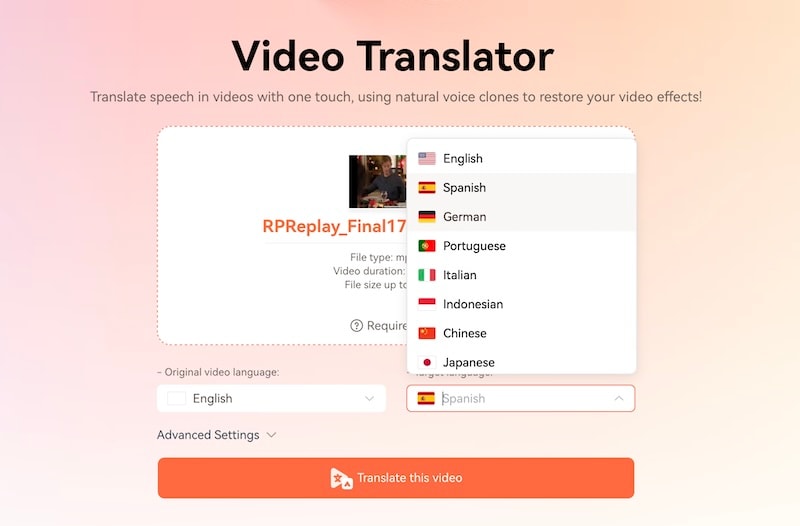
Step 3: Click Translate. When the process is over, save the translated video to a location of your choice.
ADVANCED FEATURES
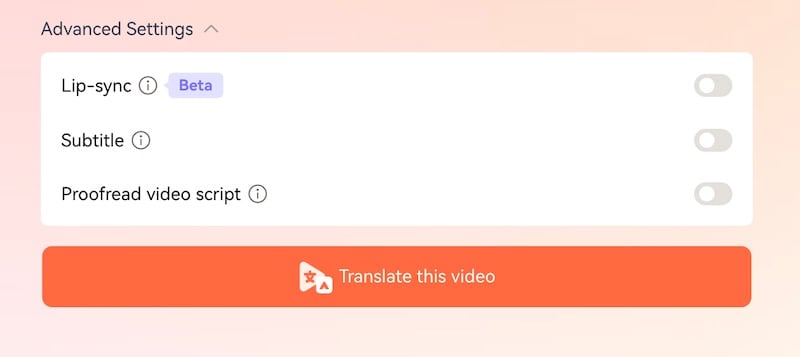
Wondershare Virbo comes with 3 advanced features:
- You can use the power of AI to create perfectly lip-synced videos in line with the target language. Try it to believe it!
- Enable Subtitle option to burn the translated subtitles directly into the video. This should only be done if there are no subtitles already present in the video.
- Enabling Proofread Video Script option automatically parses and proofreads the video script for more accurate video translation.
Translate Video Online Free Download
Conclusion
Gone are the days when you had to make separate videos for every language you wanted your videos to be in and had to hire linguists to proofread and check your subtitle files in case you were using subtitles in different languages for your videos. Today, you can auto translate subtitles online using any of the freely available online SRT translation tools. However, this guide shows you how to select the right tool for you, and as bonus, gives you an easy-to-use tool to translate videos into any language easily!
Translate Video From Japanese to English Online for Free
Let’s say you’re a business owner or a content creator in Japan. If you want to broaden your horizons, you may need to translate videos from Japanese to English. This is because English is spoken globally. You can sell more, share knowledge, and connect with English speakers worldwide.
For streaming platforms, turning Japanese content into English is a ticket to reaching audiences all over the globe. And businesses using Japanese tech might need translated training videos for their remote workers.
Seeing this growing need, it’s clear you need effective video translation solutions. So, we’ve created a guide to help you choose the best method for each step, including using AI. Finding the right way to translate videos is important, so keep reading!

Part I. Completed Process To Translate Videos From Japanese to English
When you want to translate a video from Japanese to English, you can follow some general steps, no matter how you decide to do it. Let’s break down each step for you:
- Step 1: Video Transcription
Before you can translate, you need to understand what’s being said. So, the initial step is to do a video transcription. You can either hire professionals or use a Japanese-to-English video translator app to convert the spoken language to text.
Transcription captures all the Japanese dialogue, ensuring the English translation is spot-on. Having the text file lets you edit it, like shortening sentences or adjusting cultural references. This results in a smoother and more natural English video for you.
- Step 2: Translation
Once you have the transcript, you can translate the Japanese text into English. A good translation ensures the original message is accurately conveyed in the new language. It avoids any misunderstandings or misinterpretations for your English viewers. You have two options to do it. Both have strengths and weaknesses, so let’s see which suits your needs best.
- Professional Human Translation Services
When you want to translate a video from Japanese to English, a pro can make the sentences sound right for your audience. These professionals tweak the tone to be natural and engaging. If you go to translation agencies, they make sure the work is top-notch by going through strict editing and reviewing. However, human translation services cost more and take a bit more time than machine translation tools.
- Machine Translation Tools
Machine translation tools are fast and affordable. They can be a good option for short, simple videos where perfect accuracy isn’t critical. But it often struggles with complex language, cultural references, and humor.
- Step 3: Timing and Implementation
Let’s talk about making the Japanese to English video translation seamless. After translating, you want the words to match the original rhythm and pace of the speaker in the video. It keeps things feeling natural and engaging for you, the viewer. Plus, speakers use non-verbal cues like jokes, emotions, and pauses. Matching the translated text with these visual cues keeps the video’s meaning and impact intact.
How to do it? Professional workflows often use timecode, which gives each video frame a unique timestamp. It ensures super precise subtitle placement for that perfect synchronization. Some video editing tools even have “waveforms” to help visually line up subtitles with the spoken parts.

Here are several ways to add the translated Japanese text to your video:
- Subtitles
Subtitles are like on-screen translators for you. They show the English dialogue while the original Japanese audio goes on. It helps you understand if you get the visuals but not the language. The focus is on getting the main point across and sometimes making the sentences shorter for easier reading.
- Closed Captions
Like subtitles, closed captions (CC) are words shown on the screen. They go beyond spoken words, covering all the sounds you hear, like dialogue, music, and even background noises. The main goal is to help you, especially if you’re deaf or struggle with hearing. So, if you’re aiming for videos everyone can enjoy, try a video translator from Japanese to English with CC capabilities.
- Dubbing
Dubbing is a more intricate process where the original Japanese audio track is completely replaced. Voice actors step in to record the translated script in English. They try to sync up their words with the lip movements of the characters on screen. It makes it seem like the characters speak English right from the start, giving you a more immersive viewing experience.
- Voiceover
In this method, a narrator reads the translated script in English over the original Japanese audio. It’s often used in documentaries or educational videos when you need more info beyond just the dialogue.
- Step 4: Final Review and Approval
Alright, so you’re at the last step now. You’re giving the translated video a good check to ensure everything’s spot-on – accurate, consistent, and top-notch quality. It means looking out for any problems in the translation, timing, or how you choose to do it. Once you give the thumbs up to the final version, you’ve got a smooth and effective English video ready for your audience.
You might find the previous steps tedious and time-consuming. But what if you could translate your video from Japanese to English in minutes? That way, you could reach new markets and expand your influence faster. AI video translators like Wondershare Virbo can help you spread your work, passions, and stories to a global audience. Read on to learn more.
Part II. Virbo: Realistic AI Japanese to English Video Translator
You’re excited about your new product, but your explainer video feels like it’s only speaking to half the world. You know the potential exists, but the language barrier holds you back. Or perhaps you’ve captured stunning footage from your recent trip to Kyoto, but sharing it with your followers feels like a lost cause.
Here’s the deal: you don’t have to stick to a small crowd.
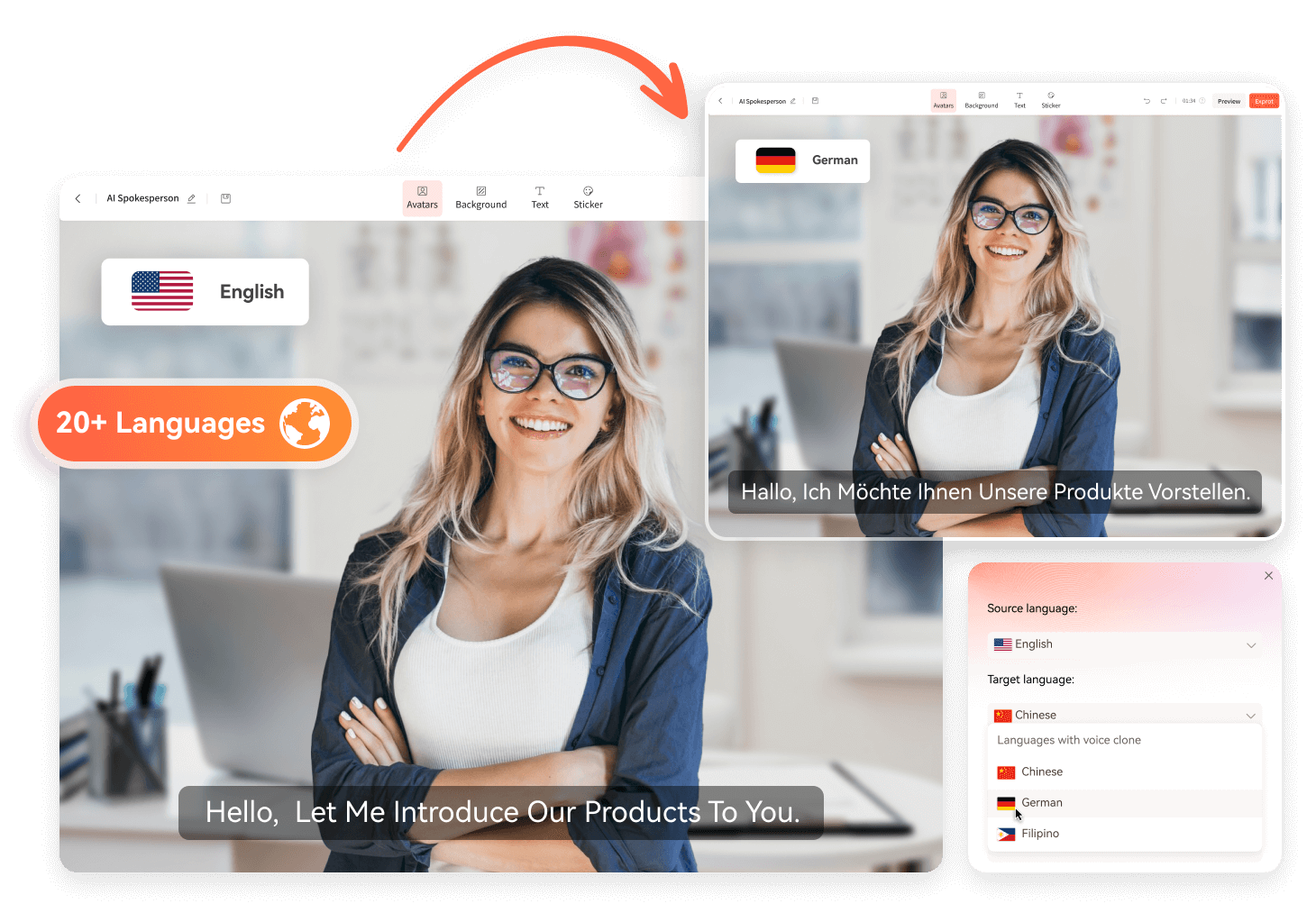
Get Started Online Free Download
Virbo uses the latest AI tech to automatically translate, dub voice, and add synced subtitles to your Japanese video. This app is simple to use and can translate video content into over 20 languages. Virbo translates Japanese to English videos in a few minutes – all free for videos under 2 minutes!
Here’s what makes Virbo stand out:
- Precise Lip-sync: Say goodbye to awkward, out-of-sync translations. Virbo AI video translator ensures the translated dialogue seamlessly matches the speaker’s lip movements and facial expressions, creating a natural and engaging experience (still in beta, but getting better every day!).
- AI Cloning Voices: Add engagement with Virbo’s AI-cloned voices that capture the essence of human speech. Choose from a range of natural-sounding voices that express the right emotions and add personality to your content.
- Soundtrack Reserved: Don’t lose the original soundtrack that sets the mood. Virbo allows you to keep it intact, enhancing its impact even in different languages.
- Versatile Compatibility: Virbo works across various platforms, including Windows, iOS, and Android. You can even use it online for ultimate flexibility.
- Affordable Excellence: Experience the power of AI video translation without breaking the bank. Virbo offers high-quality solutions at affordable prices, making them accessible to everyone.
Part III. How To Translate Japanese to English Video Using Virbo Automatically
Using Virbo AI video translator can help you be more productive. Here’s how to translate a video in Japanese to English online for free:
- Step 1: Go to Virbo AI video translator online from your browser for quick access. You can also download the app for your desktop. Once you’ve chosen your access point, sign in using your existing Google, Facebook, email, Apple, or Twitter account.
Get Started Online Free Download
- Step 2: Choose and upload your Japanese video file from your local storage. Ensure the video is between 10 seconds to 5 minutes long and in MP4 or MOV format, up to 500 MB for optimal processing.
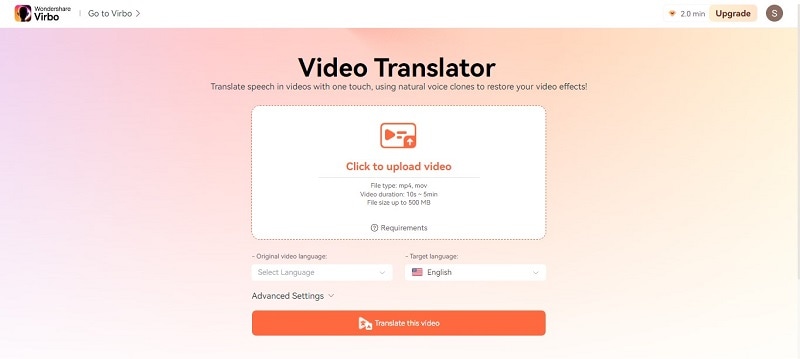
- Step 3: Specify Japanese as the Original video language and English as the desired Target language.
- Step 4: Virbo offers Advanced Settings to customize the translated view result. Toggle on the Lip-sync, Subtitle, and Proofread video script switches to enable them when needed.
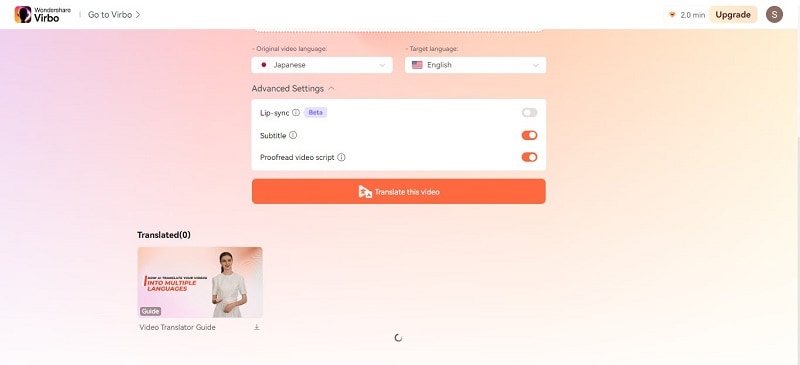
- Step 5: Click Translate this video to start the translation process once everything is set.
- Step 6: Wait a few moments while Virbo performs video transcription. Review the text and edit if needed.
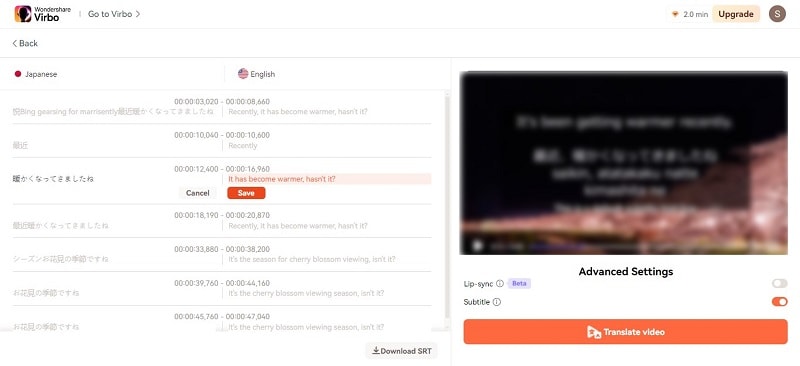
- Step 7: Click Translate video to proceed, then the video will go to the queue.
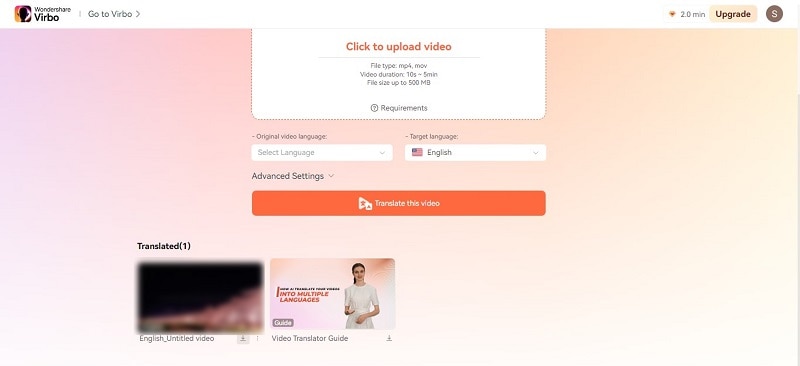
- Step 8: After completion, you can preview the translated video before downloading the final English version.
Part IV. How To Achieve the Best Video Translation Results?
You can’t always translate a video from Japanese to English without a few difficulties. Here are some ways to make the process easier for you:
Divide the Script Into Manageable Chunks
Break down the script into smaller sections like sentences, phrases, or even shorter segments depending on the video’s pace and complexity. It allows for more precise timing adjustments later.
Use a “Shadowing” Technique
As you watch the video, read the translated text out loud. Adjust the subtitle timing to match how you naturally speak. Doing this makes the flow feel more natural for you and the viewers.
Test and Refine
Now that you’ve set the timing for the subtitles, it’s time to put them to the test with your target audience. This step is important because it helps you catch any timing problems, awkward phrasing, or cultural differences that might have slipped through during editing.
Listen to what your audience says, and then use that feedback to tweak the subtitles. Your goal is to make sure they’re clear, short, and match the audience’s culture.
AI for Pre-Translation Tasks
Take advantage of AI tools for speech-to-text conversion and automatic subtitle generation. It can save time, but always proofread for accuracy and natural flow.
File Compatibility
Ensure your chosen translation service or tool supports the format of your video file. The common formats include MP4, MOV, and AVI.
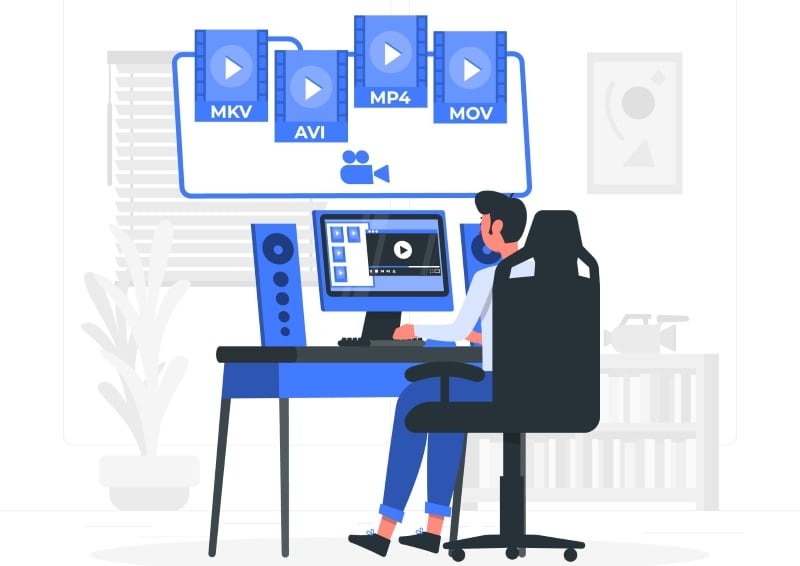
Conclusion
So you’ve seen how easy it can be to translate a video from Japanese to English. It’s up to you whether you will ask for the help of human translators, video editors, or AI video translators.
As you know, Virbo goes beyond being a basic Japanese to English video translator and converter. It takes the complexity out of translation, offering seamless and accurate results.
But remember, even the best AI translation can benefit from a human touch. Don’t be afraid to experiment and refine your translated video for the best outcome. With a little effort, you can bridge the language barrier and share your Japanese video content with the world.
A Complete Guide of Top 7 Video Language Translators
The fusion of diverse cultures and languages has become a hallmark of innovation. At the forefront of this linguistic revolution are video language translators, powerful tools reshaping how we perceive and engage with multimedia. This guide is a gateway into the transformative realm of video translation, where the convergence of technology and language transcends barriers. Our exploration will unveil the top 8 video language translators, each a beacon in the quest for seamless, cost-free, and automated ways to translate video content.
Part 1: Rise of Video Language Translators and Its Impact on Innovative World
In the ever-expanding digital frontier, the ascent of video language translators marks a paradigm shift in how information transcends linguistic boundaries. This section unravels the transformative impact of these tools, delving into their role as catalysts for innovation in a globally interconnected landscape.
01 Redefining Cross-Cultural Communication
As the world becomes a digital tapestry woven with diverse languages and cultures, video language translators emerge as key facilitators, breaking down the barriers that once limited the reach of multimedia content. Explore how these tools redefine the landscape of cross-cultural communication, enabling seamless interaction and understanding.
02 Enabling Globalized Content Creation
The impact of video language translators extends beyond mere translation, fostering a truly globalized and inclusive digital sphere where ideas flow seamlessly. Dive into how these tools empower content creators to transcend linguistic constraints, unleashing a wave of creativity that resonates with audiences around the world.
03 Bridging Communities through Shared Narratives
Innovative world-building involves more than technology; it’s about fostering connections and understanding. Discover how video language translators act as bridges between communities, enabling individuals and businesses to share their stories, ideas, and innovations with a worldwide audience.
04 Empowering Collaboration and Knowledge Exchange
As we explore the impacts, recognize how these translators empower collaboration and knowledge exchange on a global scale. They facilitate a free flow of information, transcending language barriers and enabling individuals from diverse backgrounds to contribute to the collective pool of global knowledge.
05 Shaping a Future of Inclusivity
Join us in understanding the profound influence these translators wield in shaping our innovative world, where the fusion of languages not only facilitates communication but also propels us into a future where collaboration and understanding know no linguistic bounds. Explore how these tools contribute to a future marked by inclusivity, where the richness of diverse languages enhances the global exchange of ideas.
Part 2: Explore Top 7 Translators to Translate Video Free
In this part, we will explore the top 8 video translators that stand out for their ability to seamlessly translate videos without putting a dent in your budget. From user-friendly interfaces to robust language support, each of these tools brings something unique to the table. Join us as we navigate the features and functionalities that make these translators the go-to choices for those seeking efficient and cost-free ways to translate video content.
1. Wondershare Virbo
In the fast-paced world of digital content creation, the ability to communicate with a global audience is a game-changer. Virbo, a cutting-edge video language translator app, steps into this arena, offering content creators a dynamic platform to transcend linguistic barriers and connect with viewers worldwide. As we delve into Virbo, let’s explore its unique features, advantages, and considerations.

Get Started Online Free Download
Features
- Whether you’re a seasoned creator or just starting, its user-friendly layout ensures a smooth and efficient experience.
- Its advanced speech recognition ensures accurate and nuanced translations, enhancing the audiovisual appeal of your content.
- It ensures that you can translate content dynamically as you create, providing instant feedback on how your video will resonate with a global audience.
Pros
- Its intuitive design ensures that creators of all levels can navigate the app seamlessly.
- It’s a versatile tool for connecting with diverse audiences.
- It ensures a secure environment for content creation and translation.
Cons
- It offers an offline mode; some features may be limited without an internet connection.
- For new users, the array of features may require some learning.
2. Google Translator
Standing as a beacon of versatility, Google Translate emerges as a leading video audio translator app. It supports a multitude of languages. It goes beyond traditional translation methods, offering real-time translation through the camera. Whether your content is spoken or written, it provides a user-friendly solution for diverse video translation requirements.

Features
- It boasts an extensive language repertoire, supporting a vast array of languages, making it a versatile tool for global content translation.
- It excels in translating written text. Its text translation capabilities are robust and cover a wide range of linguistic nuances.
- A standout feature is the real-time camera translation, enabling users to translate text in images or videos instantly through their device’s camera.
Pros
- It has a user-friendly interface, making it accessible for users with varying levels of technological expertise.
- It eliminates financial barriers, allowing a broad user base to benefit from its language translation features.
- It regularly updates and improves its translation algorithms.
Cons
- It may still face challenges in accurately translating complex or context-specific phrases.
- Its certain features depend on an internet connection, limiting functionality in offline scenarios.
3. Papago
Hailing from South Korea, Papago has garnered international acclaim for its accuracy and efficiency. This app supports real-time translation for both text and voice, ensuring that language is no longer a barrier in everyday scenarios or critical business meetings. Papago’s commitment to precision positions it as a reliable companion in the realm of global communication.

Features
- It accurately capturing spoken language and converting it into text, providing users with a seamless and efficient way to communicate across language barriers.
- It is known for its accuracy and efficiency in translating both text and voice.
- It provides a comprehensive range of supported languages, catering to diverse user needs.
Pros
- It incorporates human expertise, adding a nuanced touch to translations that goes beyond literal meaning
- It brings a unique perspective and precision to its translations.
- It offers offline functionality.
Cons
- It may be less known globally compared to some other translation apps.
- The interface may be perceived as more complex for users seeking a simpler design
4. Microsoft Translator
In the world of text and voice translation, Microsoft Translator takes the spotlight. This free and accessible tool caters to content creators seeking seamless translation for spoken content in their videos. Its user-friendly interface and wide language support make it a go-to choice for creators of

Features
- It boasts an extensive language portfolio, covering a diverse range of languages to facilitate global communication.
- It excels in text and voice translations, providing users with flexibility in how they choose to communicate across language barriers.
- It ensures accessibility for users with varying levels of technical expertise.
Pros
- It is recognized for its accurate speech recognition.
- It allows users to translate content directly within familiar Office tools.
- It enables multiple users to work together on translating content.
Cons
- It may face challenges in achieving the same level of fluency.
- Some advanced features may depend on a consistent internet connection.
5. SayHi
Venturing into the realm of voice translation, SayHi captures attention with its real-time translation capabilities. Ideal for creators looking for video language translator app to auto translate video in different languages, it provides a seamless experience for translating spoken words, enriching the audiovisual dimension of your videos.

Features
- It allows users to engage in live conversations and create dynamic multilingual content effortlessly.
- It supports a wide array of languages, enabling users to translate spoken words seamlessly across diverse linguistic contexts.
- It features a user-friendly interface, making it accessible for users of various language proficiency levels and technical expertise.
Pros
- It allows users to perform translations without the need for a continuous internet connection.
- It enables users to store commonly used phrases for quick and easy access during conversations.
- It enhances the precision of translations for specific regional or contextual language nuances.
Cons
- It may face challenges in accurately capturing the nuanced complexities.
- Some advanced features may depend on an internet connection.
6. Veed.io
In the realm of online video language translator, Veed stands out as a comprehensive platform that goes beyond the ordinary. With its integrated automatic subtitle generator and translator, it brings a new level of efficiency and creativity to content creation.

Features
- It excels in simplifying the subtitle creation process through its automatic generator, significantly reducing the time and effort required for manual transcription.
- The platform stands out with its translation feature, enabling creators to connect with a global audience by converting subtitles into various languages, promoting inclusivity.
- It offers a seamless integration of video editing tools, allowing users to enhance their content within the same platform, eliminating the need for multiple applications.
Pros
- It enables a smooth and efficient content creation process, saving time and effort.
- Its interface is user-friendly, ensuring a positive experience for creators at various skill levels.
- It allows users to access their projects from anywhere with an internet connection.
Cons
- It relies on a stable internet connection.
- It may not provide the depth of advanced editing tools.
7. Amara
Diving into the collaborative side of video language translator, Amara shines as a community-driven platform for creating and translating subtitles. This open approach allows content creators to crowd source translations, ensuring accuracy and inclusivity in the subtitles for their videos.

Features
- Amara is a pioneer in collaborative subtitle creation, allowing multiple users to contribute to the translation and refinement of subtitles for a video.
- It supports a variety of languages, facilitating the creation of subtitles for videos targeted at diverse global audiences.
- It embraces a crowd sourced approach to translation, enabling communities to work together on translating content accurately and efficiently.
Pros
- It ensures a diverse set of perspectives for accurate and contextually relevant subtitles.
- It makes video content more inclusive for audiences with hearing impairments.
- It supports various subtitle formats, providing flexibility for content creators.
Cons
- Users unfamiliar with the platform may experience a learning curve.
- It primarily focuses on subtitle creation.
Conclusion
In conclusion, the availability of top video language translators has transformed the way we engage with content across linguistic boundaries. Whether you are a student, a professional, or a casual viewer, these tools empower you to access a wealth of information in your preferred language. As technology continues to advance, the impact of video language translators on our interconnected world is only set to grow, fostering a global community where communication knows no linguistic limits.
How To Auto Translate YouTube Videos Into Different Languages
Are you looking for how to auto translate YouTube videos? Or are you frustrated with auto translate for YouTube feature? We know, that sometimes it works, sometimes it does not. There are limitations, and depending on your use case, you might be frustrated. Learn how to auto translate YouTube video into your language at the click of a button including the ability to auto translate YouTube video captions and subtitles. Using a third-party auto translate captions YouTube software, you can easily translate videos into a language of your choice and add matching auto translated subtitles.
Part 1: How To Translate YouTube Videos Automatically
If you don’t know YouTube recently launched the auto-translate feature for all videos, you can follow the steps below to translate YouTube video into any language:
Step 1
Go to any YouTube video that you would like to translate.
Step 2
Turn on Closed Captions by clicking on the CC button at the bottom.
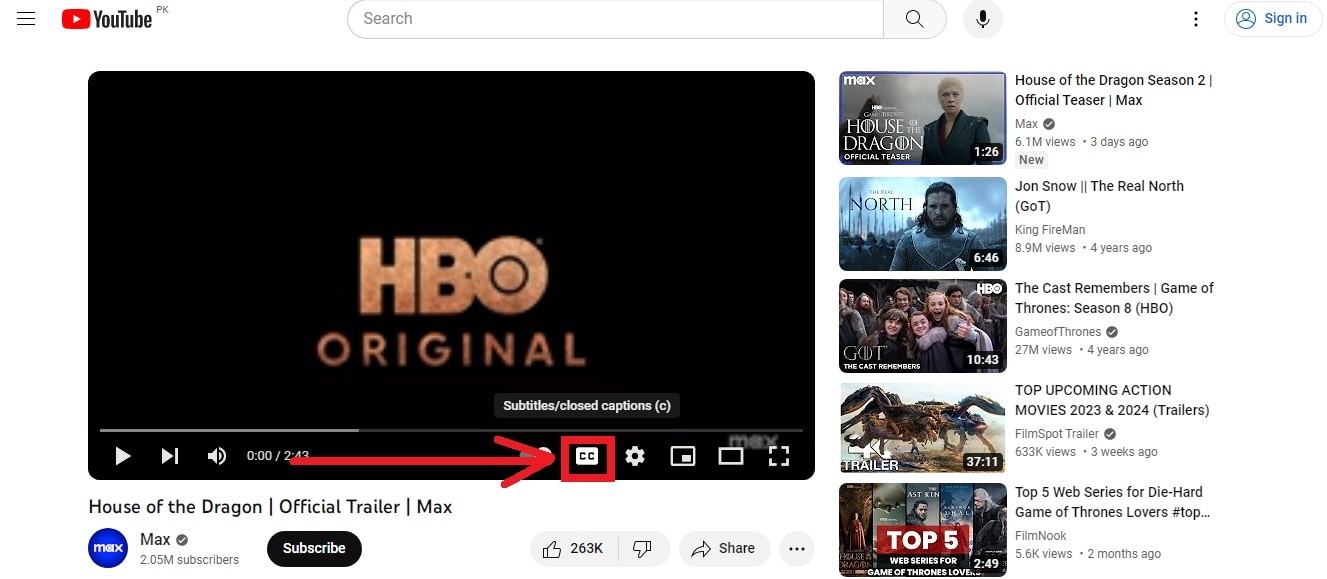
Step 3
Can you see the auto-generated closed captions in English? Good!
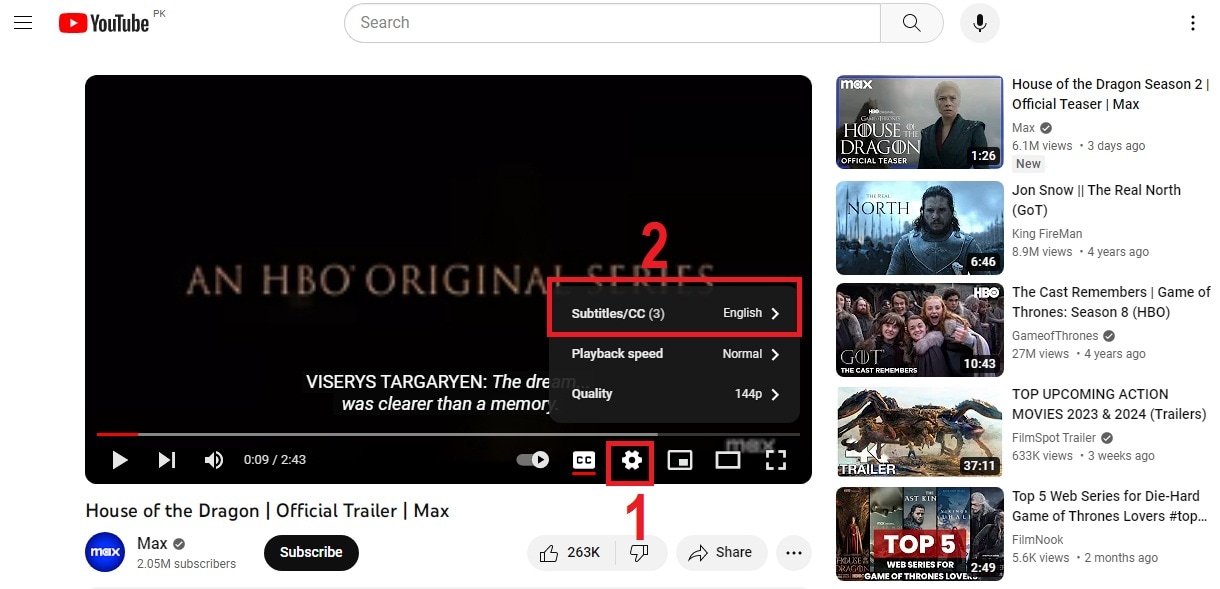
Go to Settings by clicking on the gear icon (as seen above) and click Subtitles/CC.
This will show you all the languages a video is already available in.
Step 4
Go to Auto Translate and select a language.
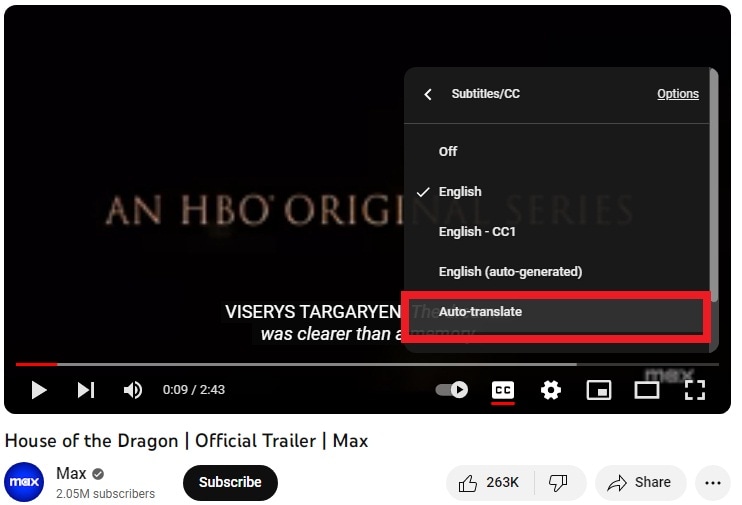
Step 5
For this example, we are selecting Hindi.
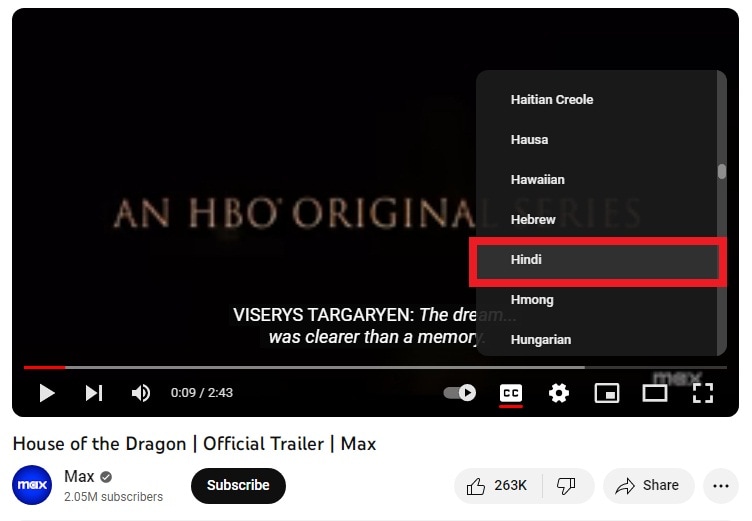
Step 6
As you can see in the screenshot below, subtitles are now auto-translated into Hindi.
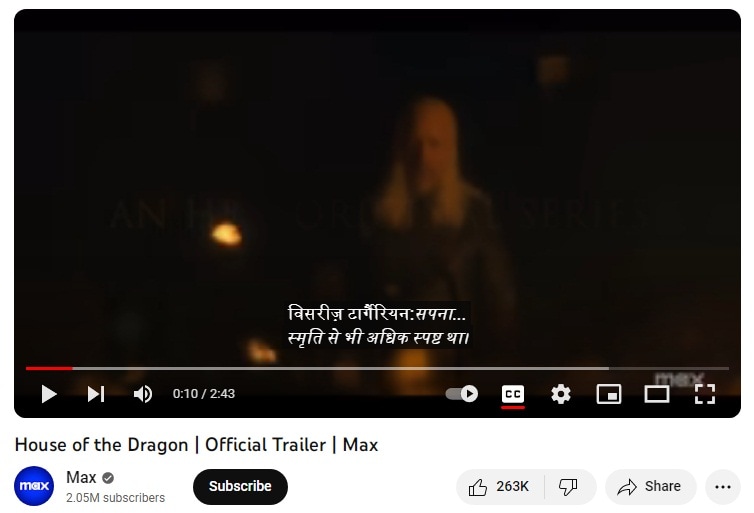
That’s all. We hope now you know how auto translate for YouTube works. With this feature, you can translate YouTube video to English, or any other language according to your needs. It’s easy and super helpful for watching content in any language.
Part 2: Limitations of YouTube Auto Translate Feature
Like all good things, auto translate for YouTube captions feature is not without its faults. Below are some of it’s limitations:
- While YouTube is slowly rolling out the feature for all languages, automatic captions still don’t support many regional languages
- If the video is over an hour in length, YouTube’s automatic caption software fails to capture the dialogue in an efficient way.
- If the video has a lower audio quality or the dialogue uses a specific word multiple times, it is hard to decipher for the auto-translate AI.
- Long periods of silence at the beginning or end of the video can also throw off the software.
- If a video has multiple speakers with overlapping dialogue, it can confuse the software and make errors in translation.
Part 3: Virbo: A Powerful Tool That Translates Accurately
Wondershare Virbo has been around for a while. You probably already know it because of its revolutionary feature of creating AI avatar videos. But they recently unveiled another fantastic new feature - AI video translation. You can use it as a language translator for YouTube video content**.**
Translate Online Free Download
Why Choose Virbo?
Most AI video translators refer only to subtitles for translation. They translate verbatim and leave out the audio lip-synching from the final product. Virbo is different because it utilizes the latest AI advancements to understand the context of a dialogue, giving you highly accurate and precise results. It also matches the lip-synching to give you synchronized talking videos in a different language. What’s more, you can also set Virbo to proofread the generated text before translation. This removes any unnecessary or repeated words, making your subtitles crisp and concise. You can also download translated subtitles as SRT or TXT files and use them the way you want.
Language Support
Virbo currently supports translation in the following languages:
English, Chinese, Spanish, Arabic, Portuguese, Indonesian, French, Russian, German, Japanese, Italian, Korean, Thai, Filipino, Bengali, Turkish, Dutch, Swedish, Croatian, Romanian, Czech, Hindi, Ukrainian, Vietnamese, Malay, Slovak, Danish, Tamil, Polish, Greek, Finnish, Burmese, Urdu
How To Use Virbo With YouTube Videos For Auto Translation
If you want to translate YouTube video online with Virbo, there are two ways to proceed, depending on your goal. We will be discussing both of these methods below
Goal 1 - You Want a Translated Synchronized Video

Translate Online Free Download
For a translated synchronized video, you can follow these steps:
- Download and install Virbo on your mobile/PC and then run the software/app(Note: You can also use the Virbo online tool)
- On the main page of Virbo, go to the Video Translator tab
- A new window will pop up, asking you to Upload your video. Drag and drop your video content.
- When the video finishes uploading, select Original and Translated languages
- Pick advanced features like Show Translated Subtitles, Keep original BG Music, etc
- Click on the orange Translate button to begin the translation
It will take some time, but the AI Translator Tool will automatically translate and synchronize the translation with the original video. You don’t need to do anything else!
Goal 2: You Want Translated Subtitles for Your Video

Translate Online Free Download
if you want translated subtitles of a published video, here’s how to proceed with Virbo:
- Upload the video to Virbo and get the subtitles translated as discussed above
- Next download the SRT or TXT file.
- Now, sign in to your YouTube Studio.
- Next select Subtitles, from the left-hand side menu
- Click on the video that you would like to add subtitles for.
- Tap ADD LANGUAGE and choose your language.
- Now, under subtitles, click on ADD to add your translated subtitles to a published YouTube video.
Easy, right? This is how to auto translate YouTube video into your language.
Frequently Asked Questions
Here are answers to frequently asked questions that you might find helpful.
FAQ 1: What to do about videos without subtitles?
For such videos, you can always use Wondershare Virbo to easily add subtitles and translate them into the target language of your choice!
FAQ 2: What to do if I need more accuracy in translated subtitles?
For such cases, Virbo online is the tool that supports proofreading the translated words. It gives you the most accurate subtitles in the language of your choice.
FAQ 3: Any way to permanently enable auto translate for YouTube on every video?
Sign in to YouTube and then, in any YouTube video, click the gear icon at the bottom right corner of the video, click Subtitles/CC, and click Settings. You will be taken to your Playback and Performance settings, where you should tick “Include auto-generated subtitles”.

Now, for every video where subtitles are available, YouTube will automatically use subtitles.
Conclusion
In case you didn’t know, YouTube provides an auto translate for YouTube feature for you to use. However, in classic Google fashion, it comes with several limitations. To remove and bypass those limitations, you can use a third-party auto translation YouTube software such as Wondershare Virbo that allows you to auto translate YouTube video into your language including auto translate captions easily on mobile, Windows PC, and even online! Try the best auto translate for YouTube software today and auto translate YouTube video into your language anytime, anywhere on PC, web, and mobile!
Translate Online Free Download
A Brief Review of CapCut Translate With Alternative
Accurate and efficient video translations are essential for reaching global audiences. They bridge linguistic barriers. Translations open doors to diverse viewership and amplify your content’s impact. The article delves into two leading tools for enhancing translations:CapCut Translate and Wondershare Virbo.
The page provides an in-depth comparison and a handy guide for using each tool’s capabilities. Whether it’s auto-translating subtitles or language nuances, these platforms streamline the localization process. Each app ensures your message resonates across borders. Explore the guide for insights and tips to elevate your video content’s reach and relevance. Read on to learn more.

Part 1. CapCut Translate: An Overview
CapCut Translate Subtitles is a nifty app that helps you make accurate and efficient translations of video content. With its intuitive interface, the app bridges language barriers and allows you to reach a diverse audience. Here are its key features of transcribe video to text by Capcut:
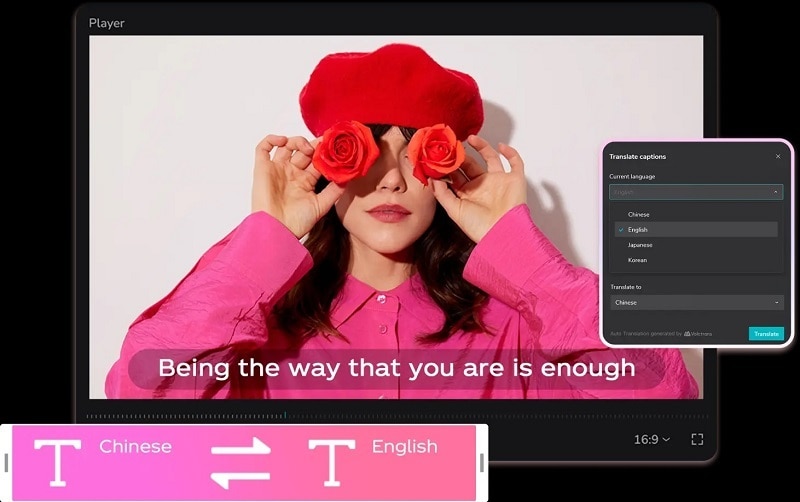
- Video-to-text translation
CapCut Translate enables you to translate spoken or written content within videos into text. The auto-translation of CapCut helps create accurate subtitles or transcripts in many languages. It enhances accessibility and comprehension for viewers.
- Multilingual subtitle translation
You can translate subtitles into various languages. The app ensures that your content is accessible to global audiences. It supports a wide range of languages. It’s a versatile tool for international outreach and engagement.
- Customizable subtitles
CapCut offers flexibility in subtitle customization. It allows you to adjust font styles, sizes, colors, and positions. You can suit your preferences or branding requirements. The customization enhances the visual appeal and readability of subtitles, enhancing viewer engagement.
Use Cases
CapCut is a valuable tool for breaking down language barriers. Here are the platform’s different use cases:
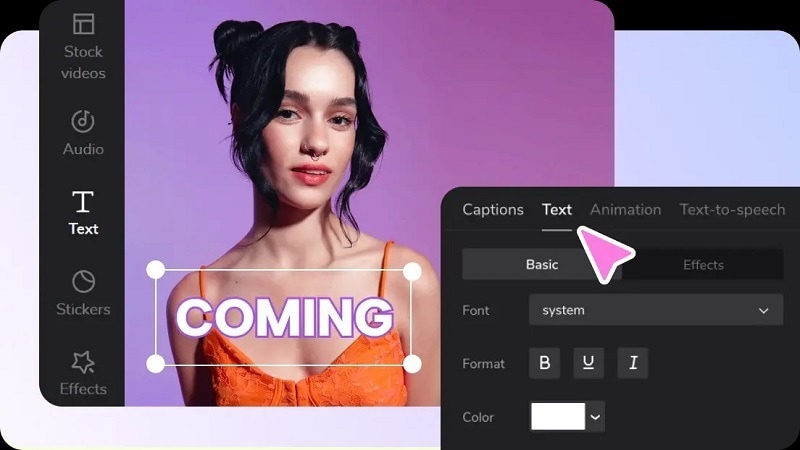
- Global marketing campaigns
CapCut Translate is ideal for businesses conducting international marketing campaigns. By translating videos or ads, companies can communicate with diverse target audiences. It maximizes brand visibility and engagement on a global scale.
- Education for special schools
The app can be used in educational settings. It can be useful for students with linguistic or hearing impairments. Teachers can create translated video lessons or instructional materials with subtitles. It ensures that all students can access and comprehend the content regardless of language barriers.
- International conferences
CapCut helps seamless communication at international conferences or events. It provides real-time translation with a few clicks. The app ensures that participants can engage in the proceedings and discussions.
How To Use Auto Translation With CapCut
Follow the steps below to take advantage of CapCut Translate’s subtitle translator for your videos.
- Step 1: Download and install the application to your computer. Launch the app. Upload the video from your computer to the platform’s interface. You can also upload via Myspace, Google Drive, Dropbox, or QR code.
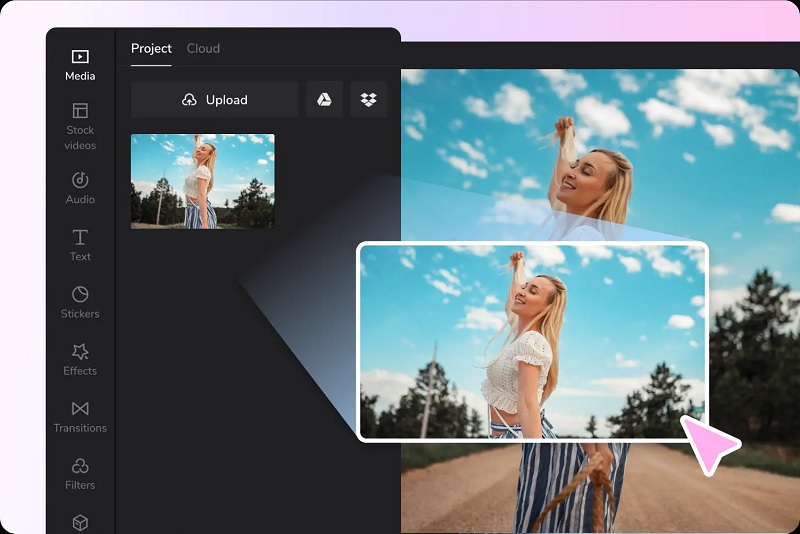
- Step 2: Once the video is uploaded, the app will detect the spoken language in your video. Next, click on Captions > Auto captions > Generate. Next, wait for the CapCut auto caption generator to process the translation.
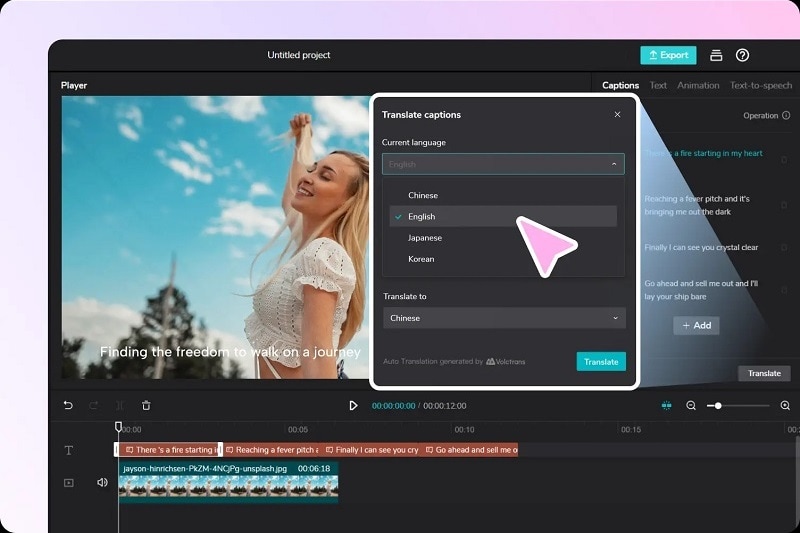
- Step 3: After translating the video content, preview the subtitles to ensure accuracy and formatting. Once satisfied, export the translated video with subtitles embedded. Share it across various platforms or channels to reach your intended audience.
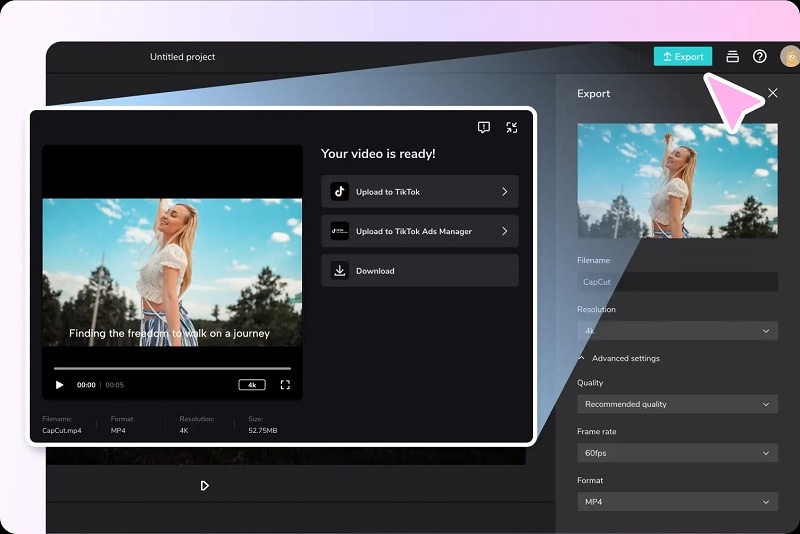
If the auto translation of CapCut isn’t accessible to you, Wondershare Virbo is an excellent alternative. It offers efficient AI-powered translation features with an intuitive interface and robust capabilities.
Part 2. Wondershare Virbo: The Perfect CapCut Alternative Assisted by AI
Wondershare Virbo is an exceptional alternative tool for video translations. Virbo empowers you to translate and enhance your video content for global audiences. Let’s delve into the platform’s key features:

Get Started Online Free Download
- Versatile compatibility. Virbo has an offline and online version. The app ensures seamless integration into your workflow.
- AI cloning voices. Virbo enables you to replicate voices with remarkable accuracy. It’s useful for dubbing or voice-over projects.
- Auto-generate scripts. The app generates scripts based on the audio content of videos. The feature saves time and effort. It allows you to focus on refining and enhancing your content rather than transcribing it.
- Soundtrack reversed. Virbo offers a unique feature that allows you to reverse the soundtrack of videos. It adds a creative dimension to your content.
- Multilingual support. Virbo supports up to 20+ languages to optimize your content.
- Subtitle translation. Virbo can automatically translate the uploaded video’s subtitles. It supports the translation tasks of 28 languages, including English, French, Spanish, German, etc.
Different Use Cases of Wondershare Virbo
With its intuitive interface and robust capabilities, Virbo streamlines the localization process. It saves you time and effort for your video content. Here are use cases where you can take advantage of Virbo:
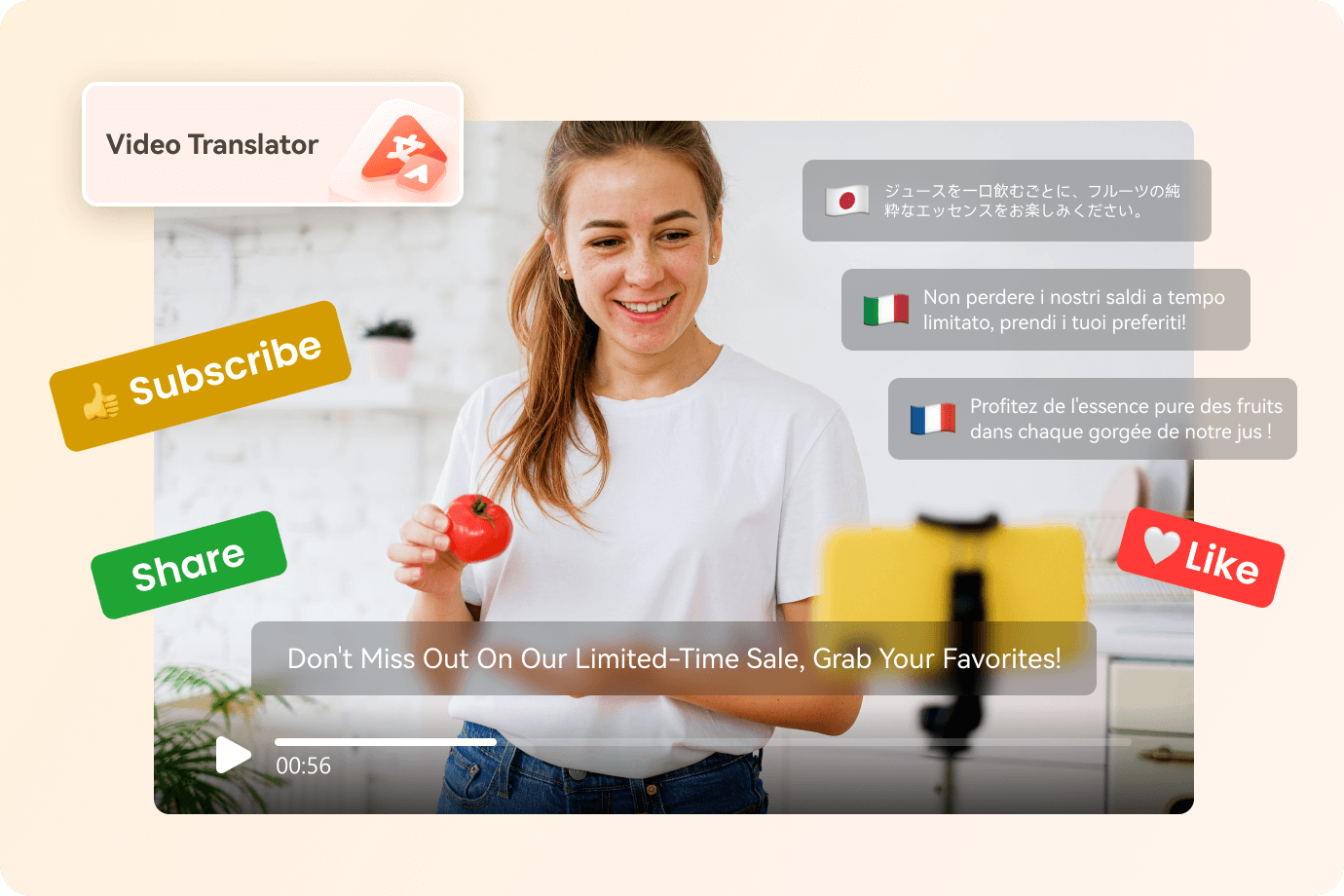
- Video advertising for global impact. Virbo’s AI translation and voice cloning allow companies to localize content for various markets. It maximizes engagement and conversion rates.
- Streamlined media production. Virbo offers automated script generation and voice cloning features. It provides content creators with efficient workflow management.
- Optimized corporate interactions. The app helps in real-time translation and voice cloning for presentations, training videos, and more. It ensures that companies can engage with employees and stakeholders across language barriers.
How To Translate Subtitles With Virbo
Follow these steps to enhance your video content and reach global audiences with Virbo:
- Step 1: Download and install Wondershare Virbo on your computer. You can also use the Virbo online tool. Once installed, launch the app. Log in with your Email, Wondershare, Google, Facebook, or Twitter account. Click the Video Translator button to start the process.
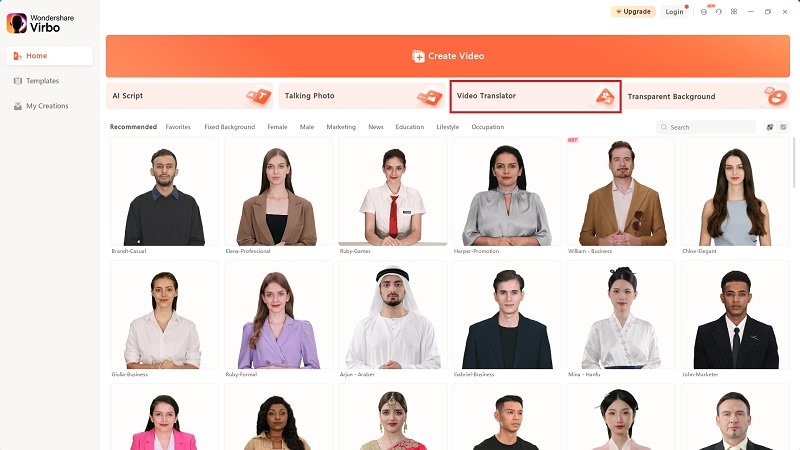
Get Started Online Free Download
- Step 2: Choose the video for translation saved on your computer. Choose the original and translated languages on the right side of the interface. In the advanced settings, decide if you like to add subtitles or lip-sync. Next, click on Translate Video.
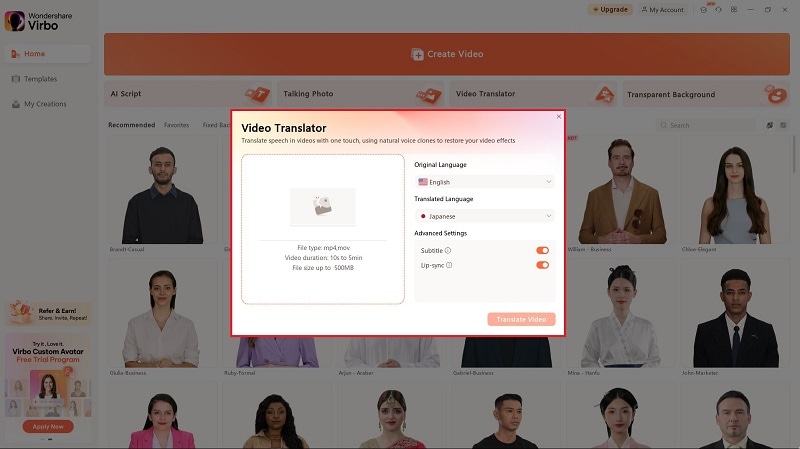
- Step 3: Wait for the translation process to complete. Once done, preview the AI-translated video to ensure accuracy and quality. If satisfied, download or export the translated video in your preferred format. Share your content afterward.
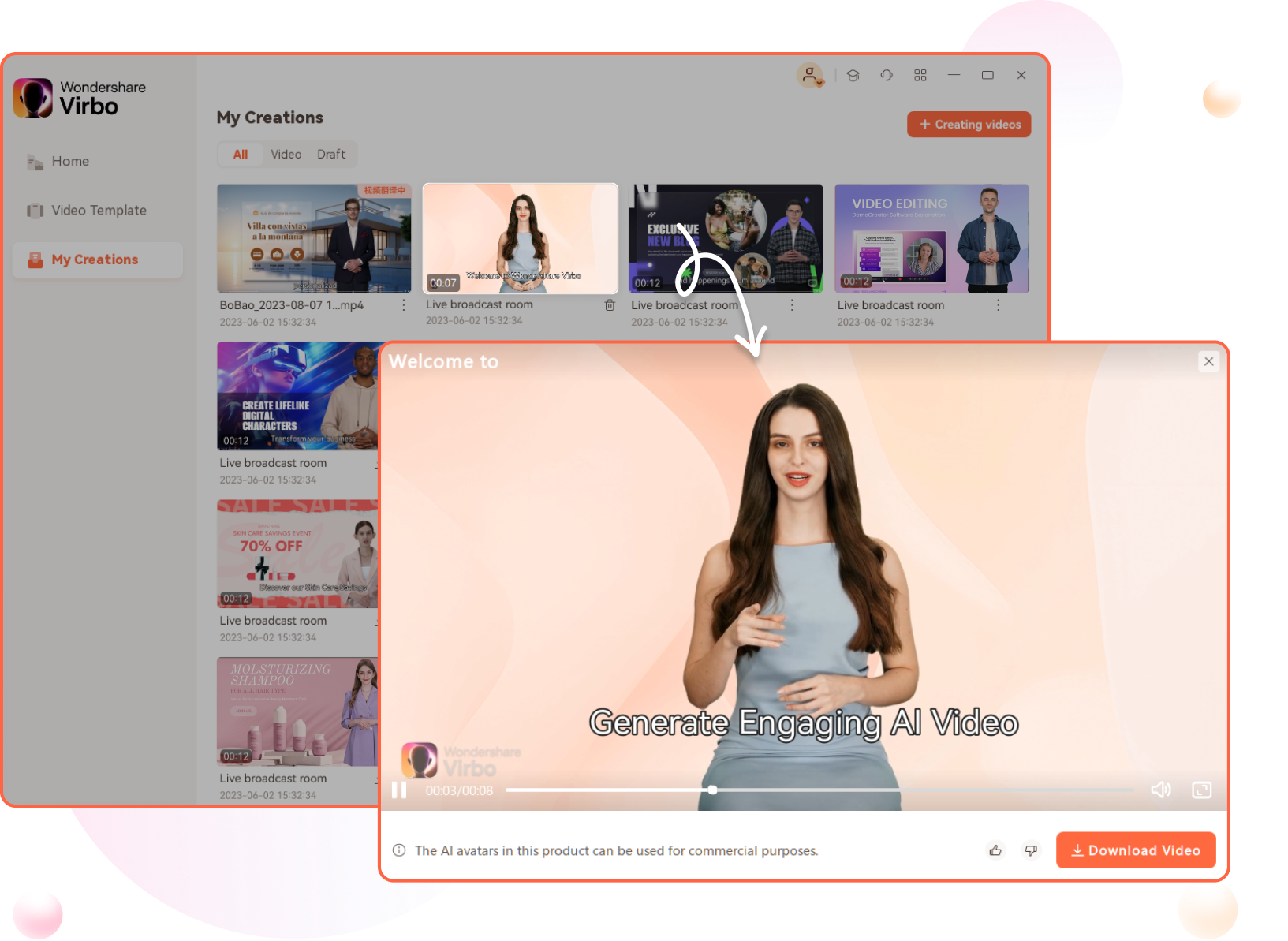
Part 3. Comparative Analysis: CapCut Translate vs. Wondershare Virbo
When considering video translation needs, several factors come into play. Here are the pros and cons of CapCut and Virbo.

CapCut Translate
CapCut Translate excels in its simplicity and affordability. Here are its pros and cons:
Pros
- · CapCut offers an easy-to-use interface.
- · You can customize subtitles from font styles, sizes, and colors.
- · CapCut auto-detects any language for easy translation.
Cons
- · CapCut doesn’t support frame rates higher than 60 fps.
- · The mobile app doesn’t support landscape mode.
Wondershare Virbo
Wondershare Virbo stands out with its advanced AI features and comprehensive language support. Here are its pros and cons:
Pros
- · Wondershare Virbo includes voice cloning and auto-script generation. It enhances translation accuracy and efficiency.
- · Virbo offers support for a wide range of languages. It ensures comprehensive coverage for diverse global audiences.
- · Virbo’s online and offline versions provide you flexibility in accessing its translation services.
Cons
- · Script generation is limited for free users.
- · Free users can only export 1 video at a time.
Pricing
Both CapCut and Virbo offer free versions. However, Virbo offers a comprehensive suite of features available on its paid plans (as of March 5, 2024):
- Monthly Plan: $9.9/month
- Yearly Plan - Essential: $19.9/year
- Yearly Plan - Pro: $199/year
The monthly plan includes 10 minutes of video credits per month. Meanwhile, the yearly essential plan provides 22 minutes per year. The annual pro plan offers 300 minutes per year. The monthly plan supports videos that are up to 2 minutes in duration. Both the annual plans allow up to 5 minutes. All plans offer a maximum resolution of 1080p and unlimited time for AI scripts.
Conclusion
CapCut Translate and Virbo offer creators valuable translation solutions. However, Virbo’s advanced AI features and language support make it a compelling choice. It’s an ideal app for users seeking top-tier translation capabilities.
The importance of selecting the right tool based on your needs cannot be overstated. It’s recommended that you test the auto-translation of CapCut and Virbo to determine the right tool for you. However, for those seeking powerful features and efficient translation, Virbo is the preferred option. Choose wisely to ensure your content reaches its full global potential**.**
Also read:
- [New] 2024 Approved From Viewers to Earnings YouTube Earning Basics
- [New] Stand Out in the Stream Top Name Generators Reviewed
- Bang for Your Buck: The Acer Predator Orion 50# Revealed – Top-Tier Tech at a Fraction of the Price
- Celebrating Android's Best MOBA Players Today
- City Escapades Games Paralleling GTA V Adventure
- Exploring High-Performance Devices: A Look Inside Tom's Hardware Universe
- Find Your Voice Flawlessly – Choose Mondly!
- Fix Cant Take Screenshot Due to Security Policy on Motorola Moto G34 5G | Dr.fone
- In 2024, 7 Fixes to No GPS - Showing Approximate Location on Apple iPhone XR Waze | Dr.fone
- Microsoft Teams Not Responding - Identifying if It's a Service Disruption or Connectivity Problem
- Modern AI Graphics Cards' Power Gluttony: Single Unit Consumes 3.7 MWh/Year, Eclipsing Homes' Energy Usage by 1.3 Millions
- Realms Reborn State-of-the-Art Virtual Experience for 2024
- The Best PC Setups for Serious Gamers : Balancing Cost with Performance
- Tom's Tech Gear: Expert Insights on Computer Hardware
- Unlocking Insights with Tom's Hardware: Your Source for Cutting-Edge Tools
- Unveiling the Best in Computing with Tom's Gear
- Title: New Best Tool to Translate YouTube Video to Arabic
- Author: Peter
- Created at : 2025-03-02 08:09:41
- Updated at : 2025-03-04 04:09:59
- Link: https://ai-video.techidaily.com/new-best-tool-to-translate-youtube-video-to-arabic/
- License: This work is licensed under CC BY-NC-SA 4.0.